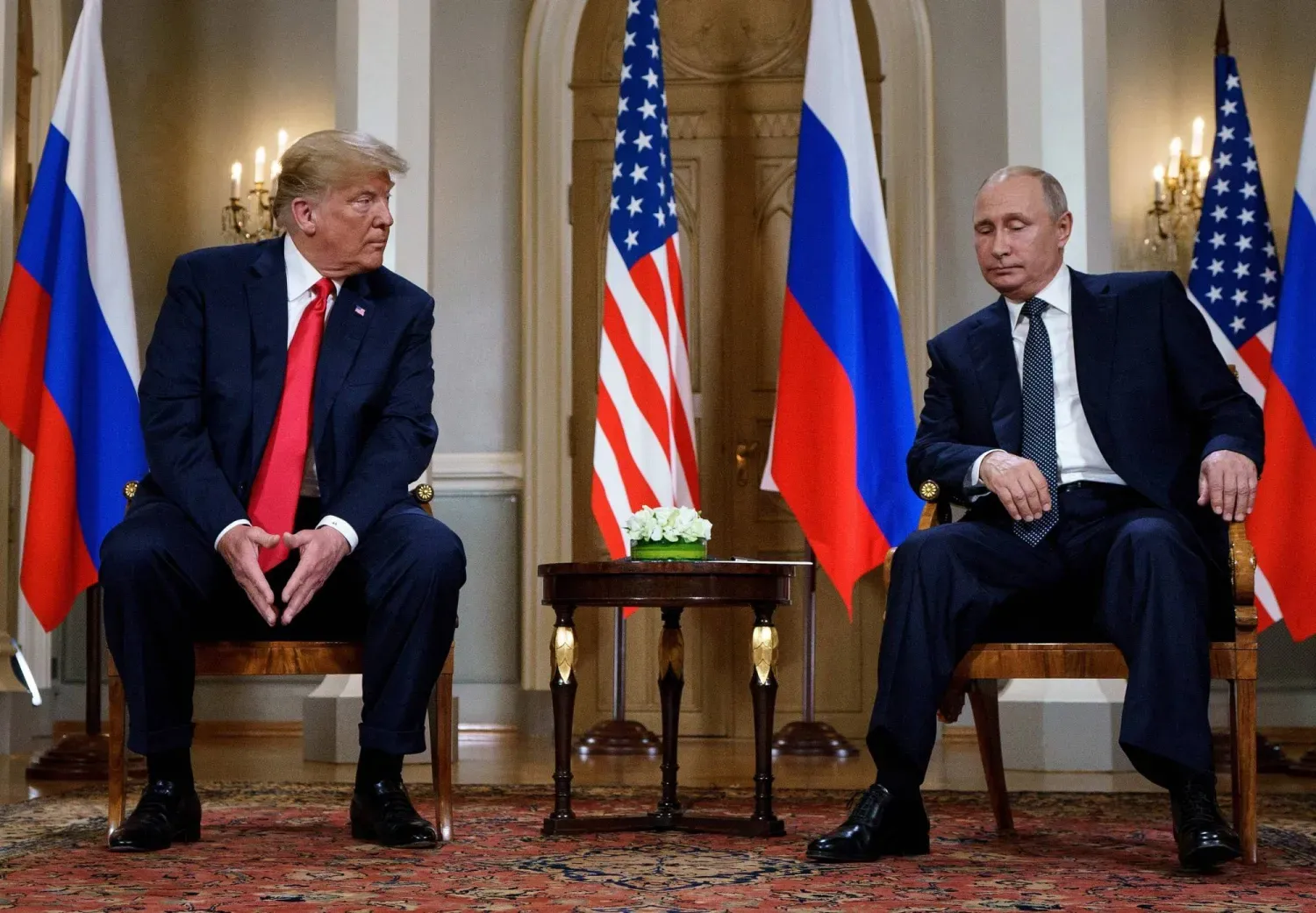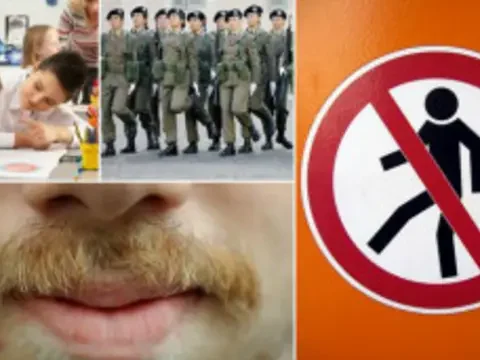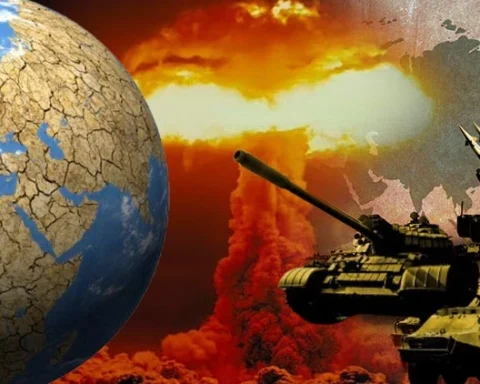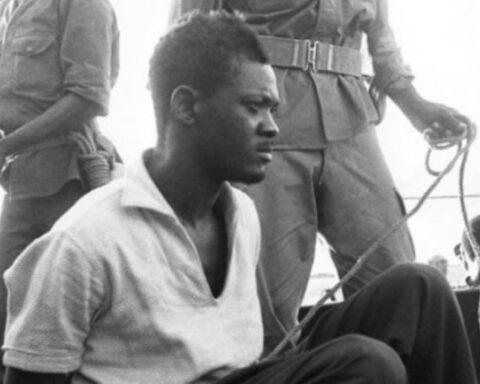In previous essays in the real free press (the US mainstream media is currently ranked 57th in press freedom by Reporters Without Borders), I discussed the sabotage operations of the CIA directed at the Soviet Union just after World War II. In its efforts to “crack apart” (CIA’s words) the USSR, the CIA worked closely with war criminals, the wartime Nazi-allied Organization of Ukrainian Nationalists (OUN), the Ukrainian Insurgent Army, and the Ukrainian-founded Anti-Bolshevik Bloc of Nations, a conclave of multiple European Nazi collaborators.
When the right-wing ultra-nationalist groups were crushed by the Soviets, the CIA recruited Ukrainian and other eastern European dissidents to work on the secretly CIA-funded Radio Free Europe/Radio Liberty. Contrary to the official story, America’s proxy war on Russia did not begin in 2022 but in fact some 75 years earlier.
Ukraine’s ultra-nationalist leaders, Stepan Bandera, Yaroslav Stetsko, Roman Shukhevych, Mykola Lebed, and others, who are now memorialized throughout western Ukraine with statues, monuments, street names, and holidays, are well documented as Nazi assets in CIA declassified reports. Bandera’s OUN directly worked with the German SS in the mass extermination of Poles, Jews, and ethnic Russians in Ukraine. Nazi insignia are today ubiquitous amongst Ukraine’s armed forces.
The background of Ukrainian nationalism is not known by the vast majority of Americans, including those in the journalism profession. Unwilling to do proper investigative reporting, the American mainstream media (MSM) serve as little more than state propaganda organs, the main organizing tools for the manufacture of public consent, as brilliantly analyzed by Edward Herman and Noam Chomsky – indeed, far more consolidated today.
It is hard to find a single story on the screens or pages of the MSM that reveals the factual truth about the background of the US global warmongering project and geopolitical and economic interests in Ukraine and eastern Europe or the fictions upon which Russophobia was constructed. Hence, there is no context in their writing about Ukraine and Russia. The news angle on Ukraine is typically cast as a struggle for democracy, even though that country is widely recognized outside the MSM as an illiberal and fiercely corrupt oligarchy.
Herman and Chomsky argued, particularly with respect to international coverage in the MSM, that five structural filters organize how foreign affairs is reported: the fact of corporate media ownership; the dependence on corporate funding via commercial advertising; the reliance on sources inside the government; anti-communism or other fear-mongering ideologies; and “flak,” the ability of organized groups, such as AIPAC, to influence foreign policy.
Apart from state management of America’s news media, which are considerably less hegemonic in the present era of social media, postwar domestic Cold War organs of public persuasion, such as the Advertising Council, public schooling, conservative religious educational institutions, the publishing and film/TV industry, and other organizational forces, contributed a great deal toward indoctrinating multiple generations of Americans to hate Russia.
Even earlier, the state-engineered Red Scare of 1919-1920 following the Bolshevik Revolution, induced public hysteria and led to the Palmer Raids and massive deportations of eastern European and Russian political and labor leaders. The second Red Scare following World War II further intensified hostility toward the Soviet Union and created a vilification culture towards Russians that lasted until the collapse of the USSR in 1991. It was revived with the ascendency of Vladimir Putin’s leadership (1999 to the present).
After a disastrous decade of US “shock therapy” conversion attempts on its economy in the 1990s involving a team from the Harvard [University] Institute for International Development, Russia was in tatters politically, economically, socially, militarily, and culturally by the turn of the century. The US-financed, managed, and rigged 1996 election of the inebriate president Boris Yeltsin laid Russia open to exploitation both by domestic oligarchs who took over the most lucrative former state enterprises and by American ideologues involved in organizing the neoconservative “unipolar moment” (that is, US absolute hegemony in the world). But as dialectics would intercede, Russia awoke from its national and international humiliation.
Within a few years, according to the later Russia scholar Stephen Cohen, following his assumption of power, the Putin government turned the economy around, ended the massive unemployment crisis, radically reduced poverty and improved living standards, significantly lowered the rates of early mortality and alcoholism, helped end the national social depression, and restored a higher level of order and national self-confidence among the Russian working class. The Russian public has consistently given him high approval ratings, averaging well over 70%, 86% in May 2025. Repression of oppositional forces has been a feature of Russian politics throughout its history, the Putin era indeed representing a relatively liberal period.
Putin also arrested oligarchs or forced them out of the country, was credited with restoring a positive sense of the future, which the people hadn’t experienced in decades, and began to again return Russia to its former position of strength in the world. Although he certainly has his domestic enemies, mostly coming from the right, ultra-nationalist side of the spectrum, Putin has remained highly respected as a leader for a quarter of a century, as registered in national polling.
This perspective on Putin’s leadership is never discussed in the highly partisan MSM, which is stuck in infantile demonological stereotypes of and prejudices toward the Russian people and their leaders – from Bullwinkle to James Bond’s nemeses to Ivan Drago to Yulian Kuznetsov in Nobody and dozens of other go-to villains, spies, vodka swilling drunks, and criminals in American popular political culture. The entertainment industry is a powerful influencer in creating or reinforcing public attitudes toward racial and ethnic groups.
And despite the rhetoric of the political class about the absence of democracy in Russia (to be sure, it indeed is not a liberal democratic state), the US has found nothing problematic about its own many active relationships with violent undemocratic regimes (or its own democratic deficits). It is clear that the US operates internationally largely on the basis of realpolitik – the pursuit of naked self-interests abroad with little concern for consistency or for genuine democratic values. The problem is that to be effective, realpolitik requires educated and sophisticated leadership, which has been absent in US foreign policy going back decades.
In the end, as far as the US is concerned, “political realism” usually results in imperialist foreign policy. What the US calls “democracy promotion” is little more than neocon-driven regime change designed to break down every remnant of socialist, nationalist, or simply self-determinist resistance to its control over other countries’ institutions, state policies and alliances, and resources. Regime change involves the US-NATO alliance versus the “axis of resistance.”
US Intervention in Ukraine and Russia as Realpolitik
With the end of the Soviet Union in 1991, Ukraine became an independent state, at the outset closely tied to Russia and with a large Russian-speaking population. According to former CIA director Robert Gates, US defense secretary at the time Dick Cheney and his undersecretary of defense for policy Paul Wolfowitz had sought to not only break up the Russian alliance structure but Russia itself. Carl Gershman, president of the US government-funded regime change organization National Endowment for Democracy (NED), later declared in a 2013 Washington Post editorial that Ukraine was “the biggest prize” in the quest to ultimately end Putin’s control and break up Russia.
In 2004-2005, the US again intervened in the country, this time in support of protests in Kiev that it helped organize, a project known as the “Orange Revolution,” and directed against the declared winner of that year’s national presidential election, the Russia-leaning candidate Viktor Yanukovych. A steady flow of anti-Yanukovych reporting from the Voice of America, Radio Free Europe/Radio Liberty, the BBC World Service, and other Western media and US-supported local broadcasting incited pro-EU activists to take to the streets.
American funds were used to bus protesters in from outside Kiev, purchase protest paraphernalia, and train street organizers using an American guide for organizing an urban-based revolutionary movement. It was a template previously employed to overthrow the governments of Serbia and Georgia and later used in many other countries where US regime change agents were operating.
Yanukovych’s strong following in the eastern and southern parts of the country was voiceless in the “Maidan” (Kiev’s central square) protests. Apart from financing and advising the Pora! student movement, the US financed opposition political organizations, and arranged meetings between their favored candidate Viktor Yushchenko, for whom they underwrote favorable exit polls, and American emissaries sent by the G.W. Bush administration.
With heavy pressure from Bush’s state department, the Ukraine supreme court ordered a new election, which brought Yushchenko to power for one scandal-ridden term (2005-2010). Yushchenko’s Chicago-born Ukrainian wife had worked in the Reagan White House and the G.W. Bush administration, which made her husband a reliable subordinate of the Washington political establishment.
Yushchenko’s opponent, Yanukovych, went on to become prime minister in 2006 and win the presidency in 2010. This set the stage for a second putsch, this time undertaken by President Barack Obama and his vice president and foreign affairs point man, Joe Biden.
Created under Reagan in 1983, NED was one of the key instruments used to carry out regime change in Ukraine, a neoconservative project under the guise of humanitarian intervention and acting in ways the CIA, curtailed at the time, could not have undertaken. An under-the-radar umbrella organization quietly funded by Congress, NED is constituted by four main units: the International Republican Institute (Republican Party), the National Democratic Institute (Democratic Party), the American Chamber of Commerce, and the AFL-CIO.
Its work has been further backed by USAID, Freedom House, the International Center on Nonviolent Conflict (a private organization dedicated to civic intervention and associated with US military intelligence figures), George Soros’ Open Society Institute (now Foundations), and the American Bar Association, which organized legal “reform efforts” in the constitutions of targeted regimes.
In 2013-2014, the US was again actively interfering in Ukrainian politics in the streets of Kiev, urging on protesters to overthrow the Yanukovych government once and for all. Biden’s secretary of state for Europe and Eurasia, Victoria Nuland, the US proconsul behind the coup, was exposed via the infamous telephone call with the US ambassador in Kiev Geoffrey Pyatt revealing that they had hand-picked the leaders of a new government even while Yanukovych was still holding on to power. Vice President Joe Biden, godfather to the coup, was the final signatory to the new leadership decision.
Petro Poroshenko, exposed by WikiLeaks as a regular informant at the US embassy in Kiev prior to the coup, was “elected” as the new president, with an American consultant managing his US-style campaign. Joining Nuland in support of the street protests were senators John McCain (R-AZ) and Chris Murphy (D-CT), who stood on a platform in the Maidan with the neo-Nazi leader Oleh Tyahnybok declaring America’s solidarity with the illegal overthrow of Yanukovych. It was a public display of America’s imperial arrogance.
In the mainstream American media, none of this aggression was treated as a violation of international law or even controversial. The effect it would have on neighboring Russia or on the Russophone population of Ukraine was not even considered. A Ukrainian scholar working in Canada, Ivan Katchanovski, revealed what the western media failed to see – that the initially peaceful Maidan street demonstrations quickly broke down into a bloodbath, as multiple neo-Nazi organization (such as Right Sector and Svoboda) snipers from their positions in nearby buildings and the Hotel Ukraina shot protesters and state riot police (Berkut) before they began firebombing government buildings with Molotov cocktails.
His life threatened at that point, Yanukovych, who had already agreed with opposition leaders to hold early elections, was forced to flee the country. The western media also failed to report the May 2014 raid by right-wing militants who trapped anti-coup dissidents in Odessa in the Trade Unions Building and then burned to death or otherwise suffocated by smoke inhalation 48 ethnic Russian Ukrainians.
This act of brutality helped set off an autonomous movement of the heavily Russophone Donbas region (Donetsk and Luhansk) to which the coup government responded with a brutal assault on these eastern provinces (oblasts). Before the Russian “special military operation” in Donbas began in 2022, Kiev’s attack in the east had already resulted in nearly 15,000 deaths. The Kremlin first reacted to the anti-Russia coup and NATO threats to expand into Ukraine by (re)annexing its historic naval facility Sevastopol, which assured continuous access to the Black Sea, and reclaiming through a province-wide referendum the heretofore Crimean autonomous republic as a whole.
Beyond the Odessa firebombing incident, the citizens of the Donbas region were subjected to new policies of the Poroshenko government that were designed to eradicate the Russian language, spoken as a first or second language by the vast majority of Ukrainians, in order to “purify” the Ukrainian nation. This is known as cultural genocide.
The Poroshenko and Zelensky governments undertook policies of political repression against parties and politicians, the closure of both Russian language and other independent media, the ending of Russian and other minority language usage in the courts and other public places, and other forms of suppression of ethnic Russian and minority cultures, political dissidents, and the Orthodox Church. Such acts went almost entirely unreported in the collective West’s Russophobic MSM.
Starting in 2014, eight years before the Russian “special military operation,” the US military operating in multiple sites began training and equipping Ukrainian troops, including the openly fascist Azov battalion and Right Sector, for war in Donbas. Coup president Poroshenko described the main objective of the training as “to learn how to beat Russia.” Biden’s defense secretary Lloyd Austin later expressed a similar idea: “We want to see Russia weakened to the degree that it can’t do the kinds of things that it has done in invading Ukraine.”
Austin had personal reasons to keep the war going, as he was a useful surrogate for Raytheon Technologies (now RTX), the second largest defense contractor in the world, where he previously served on the board of directors. Biden as well was attentive to the corporate suites, being the recipient of nearly $1 million in campaign contributions for his 2020 presidential campaign from the world’s largest defense contractors Lockheed Martin and Raytheon.
Adam Schiff, then-chair of the House Intelligence Committee offered the most absurd rationale for using Ukrainian “Buffalo soldiers” to destroy Russia: “the United States aids Ukraine and her people so that we can fight Russia over there and we don’t have to fight Russia here” – a rhetorical line adapted from the “war on terror.” It is beyond any doubt a proxy war.
US Unending Aggression toward Russia
When Boris Yeltsin shelled the Russian parliament in 1993 to block a movement to oust him as president, US secretary of state Warren Christopher praised him for his “superb handling” of the political crisis. It was the deep state’s view that the collapse of the Soviet Union and ending of Communist Party power in Russia spelled a new dawn for an unimpeded thrust of American power into central and eastern Europe. Weak Russian leadership served America’s global interests.
George H.W. Bush’s secretary of state James Baker told Soviet Communist Party General Secretary Mikhail Gorbachev on 9 February 1990 that in exchange for Germany becoming reunified and a member of NATO, “there would be no extension of NATO’s jurisdiction for forces of NATO one inch to the east” (emphasis added). Unfortunately, Gorbachev had naively assumed that this understanding, one also shared by the West German government, was settled with a handshake. This is one reason why Gorbachev, a noble leader in western eyes, is seen as a traitor who, in the view of a large majority of Russians, destroyed Russia’s economy and power status with the adoption of market-oriented perestroika.
Bill Clinton broke the “one inch to the east” agreement by expanding NATO into Poland, Hungary, and the Czech Republic, and each US president since then has pushed the military organization’s boundaries ever closer to Moscow. A June 2021 NATO summit reiterated the 2008 Bucharest Summit’s pledge to set a pathway for Ukraine’s entry into the organization.
For Russia, NATO forces on its doorstep is the most serious existential threat to its sovereignty and security since Operation Barbarossa. It is hard to make a case that Russian’s invasion was without provocation. Under the circumstances, its intervention can reasonably be seen under the principles of realpolitik as preemptive.
Indeed, it is hard to fathom how a country like the US, which was prepared to launch a nuclear war against the Soviet Union in 1962 over the “missile crisis” when the Khrushchev government attempted to install military bases in Cuba, could not see Russia’s perception of NATO at its front door as confrontational and an act of aggression.
American foreign policy leaders appear incapable of rational thought in terms of protecting the credibility of their political system. The duplicity of US policy both at home and abroad is starkly obvious. The US supports secessionist movements in their mother countries without any underlying principle or justification. Examples include the breakaway Chinese province of Taiwan, which the warmongering deep state regards as a de facto protectorate of the US. The US also backs the independence of Tibet, which has been part of China for over 750 years, and immediately recognized the separation and creation of South Sudan in 2011.
Similarly, the US militarily intervened in Serbia in support of Kosovo’s secession from that country in 2008. In that instance, the US accused Serbia of “ethnic cleansing,” yet is deaf to the same claims made by Russian-speaking people in the Donbas region. During the Cold War, the CIA, with MI6, materially supported guerilla movements in the Baltic states against the Soviet Union. Closer to home, the US recognized the secession of Texas from Mexico, which it later annexed, leading to an invasion of that country (1846-1848). Under the standards of US foreign policy, would not Mexico today have a legitimate irredentist claim to that lost territory?
By contrast, Washington has not recognized the secession of Crimea from Ukraine, a part of Russia for most of the past 250 years, despite a referendum in the region that showed overwhelming endorsement of the act. (Kosovo did not even bother to hold a referendum.) How do liberals and so-called leftists in the Democratic Party fail to see US intervention in Ukraine as pointedly directed at regime change in the Russian state, especially when viewed with awareness of the long and well-documented history of American imperialism, globalism, neocolonialism, and NATO expansionism?
The American ruling class, including the owners and management of the MSM, the intelligence bureaucracies, elite university intellectuals and trustees, Wall Street, Silicon Valley, the military-industrial complex, Congress, and both political parties almost to a person vilifies Russia and supports aggression toward Ukraine in the name of defending democracy. And yet when the opportunity came to solve the internal east-west conflict within Ukraine via the Minsk peace protocols of 2014-2015, Poroshenko, with concurrence from then-leaders of Germany and France as signatories of the agreement, admitted that the meetings were intended merely to stall and buy time for Ukraine to prepare for war with the autonomy-seeking eastern provinces and their Russia backers.
A second attempt at a peace agreement in April 2022 was thwarted by the Biden administration and its stand-in, British prime minister Boris Johnson, who threatened then-president Zelensky to fight on and refuse to accede to the status of neutrality or lose western economic support. Indeed, UK Tory opposition leader in the UK, Kemi Badenoch, declared that Ukraine has been fighting a “proxy war” against Russia on behalf of western Europe. According to the international relations scholar John Mearsheimer, Putin made good faith efforts to avoid war with Ukraine but was “bamboozled by the West.”
Although the mercurial Donald Trump initially seemed to offer in his second term a refreshing new approach, diplomacy, to the conflict, he also made a number of bombastic statements about Russia and Putin once he realized that he wasn’t about to get an overnight victory and easy shot at the Nobel Peace Prize. If it wasn’t already obvious to the Russians, his “Pearl Harbor” attack on Iran, must have convinced them that they could not rely on any form of diplomacy with an unstable narcissist.
The inescapable reality is that Ukraine is not simply Biden’s or Trump’s war at this point. Rather, the US and European intervention in Ukraine has involved a long and continuous progression of aggressive attempts since the end of World War II to break up the Soviet Union and Russia and create an unending unipolar future. The power sources driving this policy for the past 80 years have been multitudinous, creating a complicated “overdetermination” (pace Louis Althusser) of America’s Cold War and now Hot War policies toward Russia that for a medley of motives end up consolidated behind a unified objective. Peace initiatives face an extremely difficult task of disabling all the power blocs aligned with warfare.
Russophobia has been the core ideological and instrumental force behind American foreign policy, an ideological construction that since the end of World War II has been critical to sustaining US hegemony and its military-industrial complex. The MIC constitutes numerous institutions and interests. These include the Pentagon and its top brass in the armed forces, combat enthusiasts in Hollywood, the gaming industry, the mainstream media, and the DC thinktanks, along with corporate hegemonists, the CIA other intelligence organizations, and most members of Congress. They are joined by Ivy League university professors and government bureaucrats who utilize Russophobia as a career pathway, religious zealots who believe that religion is restricted in Russia, and racist fascists who regard Russian Slavs as untermenschen.
“Russiagate” has been a prolonged hoax cooked up by members of the Democratic Party, their allies in the intelligence community, and the MSM to both discredit Trump as a supposed agent of Putin and to fan the flames of Russophobia as mass psychological gaslighting of the public in preparation for the proxy war in Ukraine. The culture of Russophobia has a path dependency from which there may be no escape because of the complex forces arrayed in maintaining it.
The German political “realist,” later turned Nazi, Carl Schmitt argued that powerful nations must have enemies in order to maintain strength through a mobilizing effort at building national unity. America too has its Carl Schmitts in the “bipartisan” neoliberal and neoconservative camps. The big question is whether there is an emerging dialectical force in America that can turn around the current trajectory toward nuclear war in favor of peaceful diplomacy and non-superpower coexistence and collaboration.
*Gerald Sussman is professor emeritus of politics, urban studies, and international studies at Portland State University. He is the author of seven books, the most recent of which is British and American Electoral Politics in the Age of Neoliberalism: Parallel Trajectories (Routledge, 2024). He is also the author of Branding Democracy: U.S. Regime Change in Post-Soviet Eastern Europe (Peter Lang, 2010) and numerous articles on U.S. foreign policy and state propaganda. He can be reached at [email protected]
Source: https://www.counterpunch.org/2025/07/08/proxy-war-us-regime-change-in-the-russian-federation/






